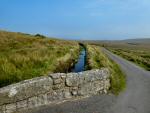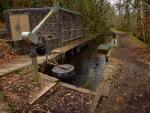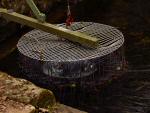| Dartmoor is full of leats; the word comes from
the Old English word 'wætergelæt' which means a ‘water
channel’. They were designed to extract water, by means of gravity,
from natural water courses to serve man in a variety of uses; for farming,
domestic and industrial purposes. The leats were builit by skilled workmen
to follow the natural contours of the moor to achieve a manageable flow
of water, fast enough to avoid stagnation but slow enough not to flood and
overspill their course. Nowadays many leats, without constant human maintenance,
are merely dry, shallow channels that only hold water for short periods
after heavy rain. However, Devonport Leat still fulfills much of its original
purpose. Built between 1795 and 1802 to supply water to Devonport, Plymouth
(originally known as Plymouth Dock), the leat ran for a total distance of
27 miles (43 km). It takes it initial suppy of water from its head weir
on the West Dart, a short distance to the north of Wistman's Wood. It picks
up further supplies from weirs on the Cowsic river and the Blackabrook river,
further down it obtains additional supplies from the River Meavy and the
Hart Tor Brook. It no longer takes its water all the way to Devonport, the
"living" portion of it (approximately 17 miles in length) now
terminates at Burrator reservoir with some of its water going to the Dousland
water works and the rest falling down a waterfall into Burrator Reservoir.
However parts of the dry part of the leat can still be seen along its route
from Dousland, through Yelverton then running in parallel through much of
Roborough Down with Plymouth (or Drakes) Leat. Much of it is lost under
the modern city of Plymouth although remnants of it can still be seen in
the Crownhill retail park. |





























